Vasari House in Arezzo: the history and new life of the museum
Giorgio Vasari, admirable architect and painter, as well as historiographer, best known for his Lives, before tying his affair to the Medici family and thus to the city of Florence, bought a house in his hometown of Arezzo. Today it is one of the few well-preserved examples of artist’s houses, and houses inside, within the walls frescoed by the painter himself, a small collection of paintings by artists contemporary with Vasari, as well as some of his own works. The purchase of the house took place on September 7, 1541, with the signing of a contract with a kiln owner, Jacopo Nanni dei Cavaceppi, for the acquisition of a building with some land, located in the upper part of the painter’s native village and surrounded by hills and vineyards, now encompassed by the city. By then in his thirties, the artist led an itinerant life due to numerous commissions, and the need for a fixed location became especially apparent shortly before 1550, in view of his marriage to Niccolosa Bacci, more than twenty years Vasari’s junior.
The house, spread over three floors, was not particularly large, but the renovations and decorative apparatuses made by Vasari helped make it a particularly refined residence. The building consisted of a basement, the piano nobile and the second floor, accompanied by service rooms, intended for servants. The decoration of the piano nobile, where he resided with his family, took Vasari seven years, carrying it out between 1541 and 1548, due to the numerous commitments that forced him to move around Italy. Already a few years later, however, in 1555, the painter moved to Florence, where he stayed permanently after obtaining a house in Borgo Santa Croce from the Medici, and returned to Arezzo only occasionally.
When he died, as he had no children, his property passed to his heirs, and the last of these, in 1687, donated the house to the Fraternita di Santa Maria. Sold by the fraternity in 1695, the building was then taken over in the late 19th century by the Paglicci family, and purchased in 1911 by the state to make it a museum space. In fact, since 1955 the house has been converted into a museum, and houses a collection of paintings from the Uffizi depository.
In the various rooms, frescoed between 1542 and 1548, there is a vivid memory of Vasari’s experiences in Venice, where he had gone at the invitation of his friend Pietro Aretino, who was preparing his comedy La Talanta, for important commissions such as the ceiling of Palazzo Corner Spinelli. We know from the painter himself, thanks to his Ricordanze, that the first room in Casa Vasari to be decorated was the Camera della Fama e delle Arti, between August and September 1542, soon after his return from Venice. On the ceiling of the room is a female figure, with her hair gathered in a tail lifted by the wind, who sits on the globe; in her hand she holds two trumpets, one flaming, to deceive backbiting, and one representing good: she is Fame, represented according to the iconography Vasari describes in the Zibaldone . The side corbels depict the Allegories of the Arts: Poetry, depicted as a laurel-crowned maiden caught in the act of writing, Sculpture, which with a chisel chisels out a block of marble, while Painting, armed with palette and brush, paints a figure.Architecture, concentrating, points the compass at the sheet.
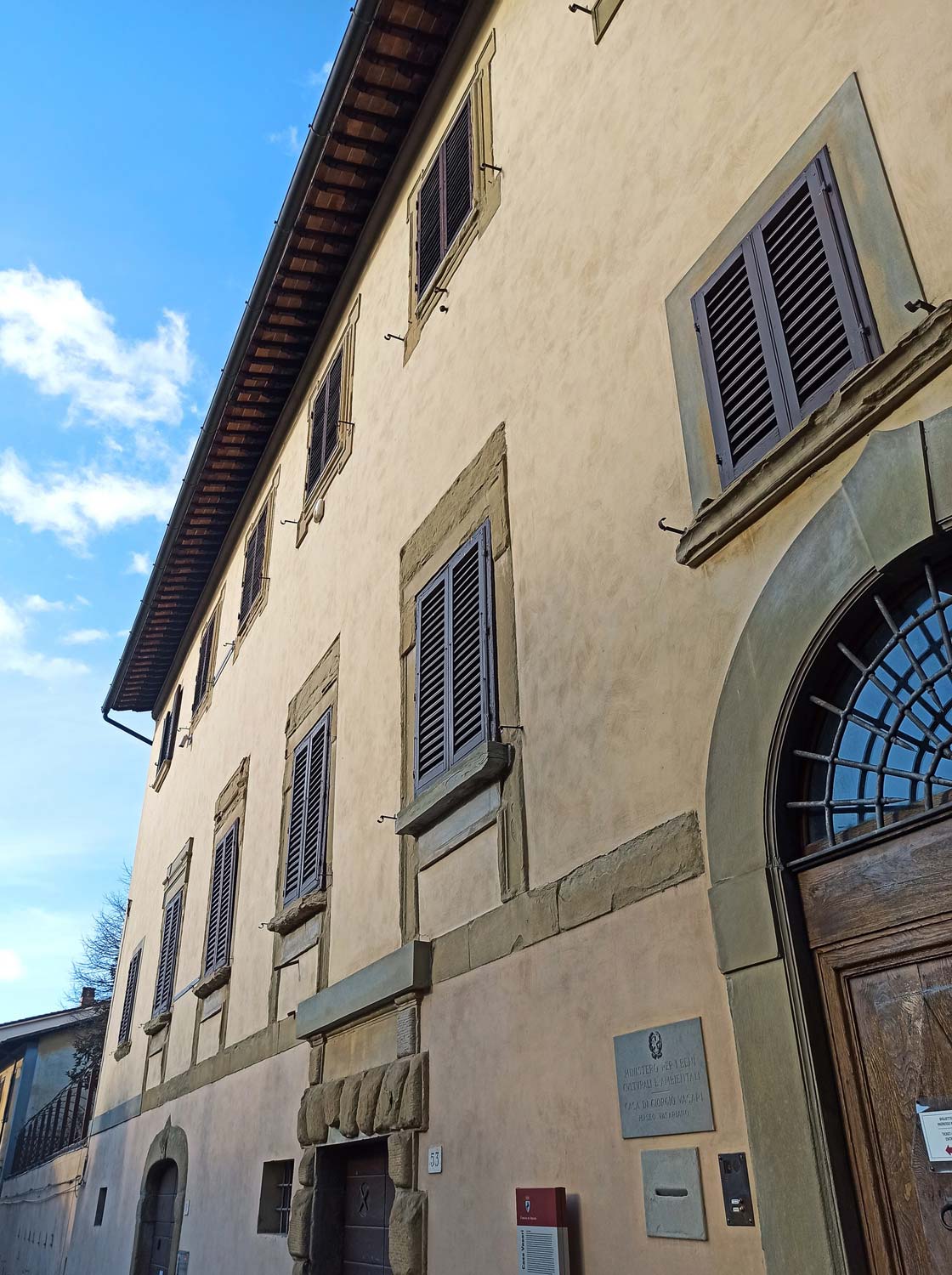

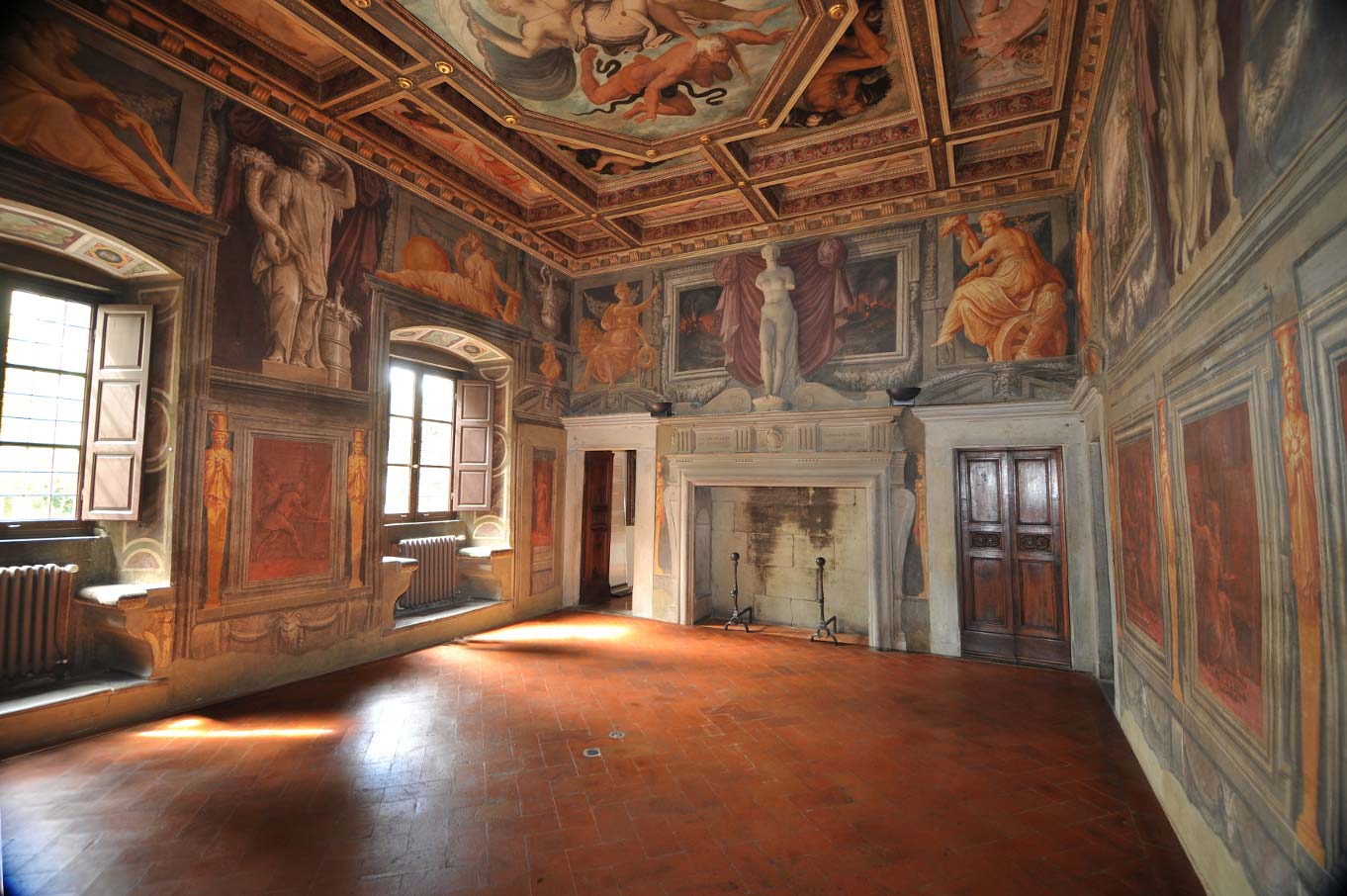
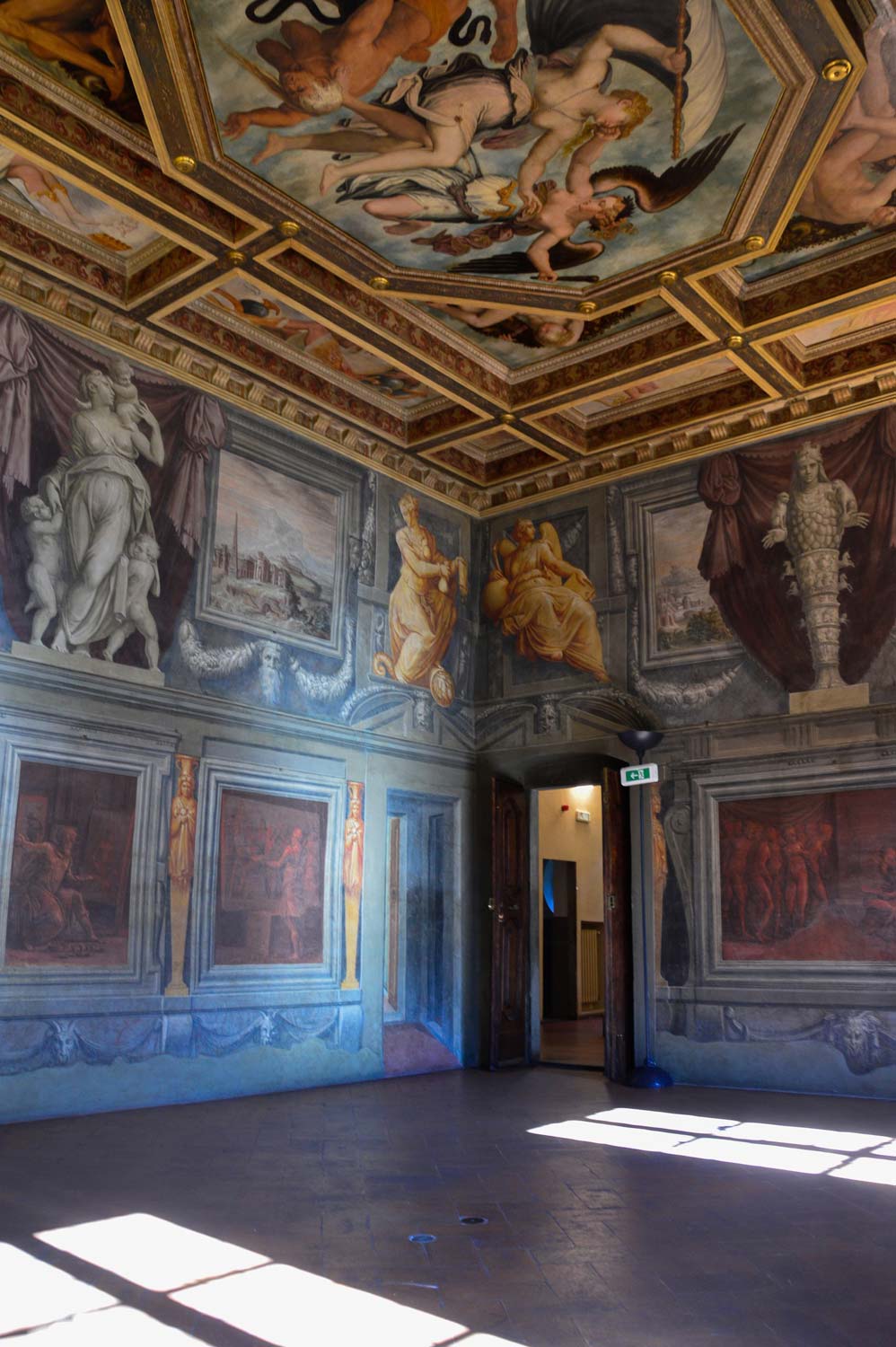
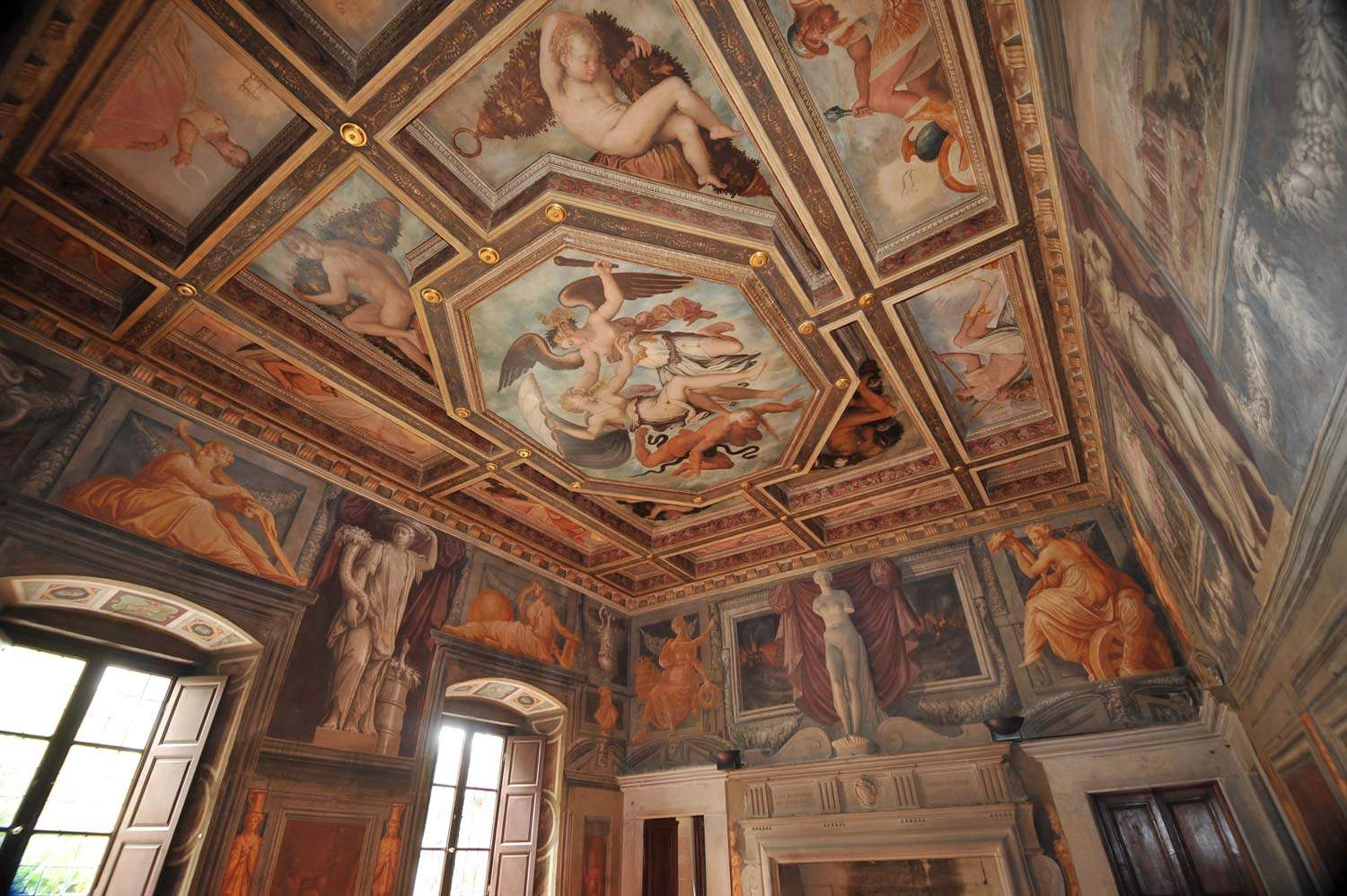
It was made later, probably after 1568, the series of oval frames containing portraits of distinguished artists. Positioned in the lower part of the ceiling, they recall the engravings with portraits of artists that Vasari added in the second edition of his famous Lives. Artists familiar to him and connected to Arezzo are also depicted, as a celebration of the artist’s relationship with the city. These portraits have been altered and darkened by repainting, probably done by Arezzo painter Raimondo Zaballi, who restored all the paintings in the house in 1827.
The bridal chamber, completed on May 9, 1548, is called the Abraham Room, and it is the room where the painter, given the private nature of the room, experimented most in his choice of subjects and techniques. Indeed, on the ceiling he used egg tempera, which gives the paintings brilliance. The central tondo of the ceiling depicts Abraham with God the Father blessing his seed, an auspicious theme for future marriage but one that would turn out badly, as no children were born from his marriage to Niccolosa. On the four sides of the square containing it are the panels with the Allegories of Peace, Concord, Modesty and Virtue, represented as four young female figures holding in their hands the symbols identifying the allegory. Then one encounters the room known as the Chamber of Apollo and the Muses, from the protagonist of the fresco created on the vault, where the god Apollo is depicted seated holding a bowed instrument, more like a violin than the classical zither, while some cherubs twirl around crowning him with laurel. The spandrels of the vault depict the nine Muses, recognizable by their attributes, among whom his wife Niccolosa is also thought to have been portrayed. Both the tondo with Apollo and the spandrels in this room appear almost to be oil paintings, an impression given by a coating of wax applied by Zaballi during restoration.
The most richly decorated room is the Hall of the Triumph of Virtue, or the Hall of the Fireplace, which served as a reception room, dominated by the monumental stone fireplace. Here the artist created a more extensive and complex decorative apparatus than in the other rooms of the house, to which he also devoted ample space in his Autobiography.The walls are completely frescoed and the wooden coffered ceiling consists of 17 decorated panels. The large octagonal panel depicts the Triumph of Virtue struggling with Fortune and Envy, represented, according to iconography derived from Ovid’s Metamorphoses, as an emaciated old woman with two snakes. Surrounding the central panel are the Allegories of the Seasons, symbolizing the four ages of man. Both the decoration within the panel and the seasons are made with oil colors, which have undergone major alterations over time, especially the greens. In the outer band of the ceiling are panels depicting the gods accompanied by their respective signs of the zodiac, as a reminder of how every man’s life is always subject to astral influences, while in the four corners are putti bearing the Vasari family crest.
The outer panels are painted in tempera, while the octagon is done in oil; the difference in painting technique between the various parts of the ceiling could be explained by the need to avoid too obvious a detachment between the ceiling and the frescoed walls: using a more similar technique gives an impression of greater homogeneity. These technical differences, as well as a profound difference in style, suggested that the panels might have been done by Cristoforo Gherardi, one of Vasari’s best pupils and close collaborator.
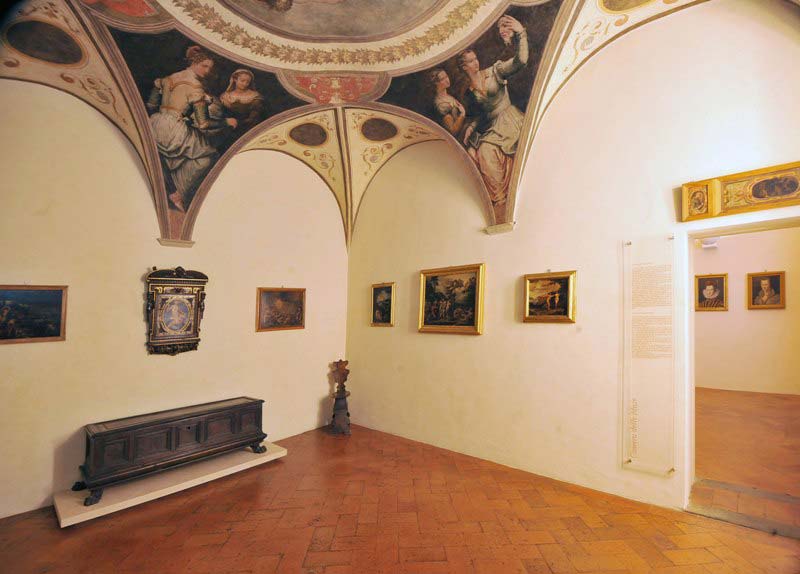
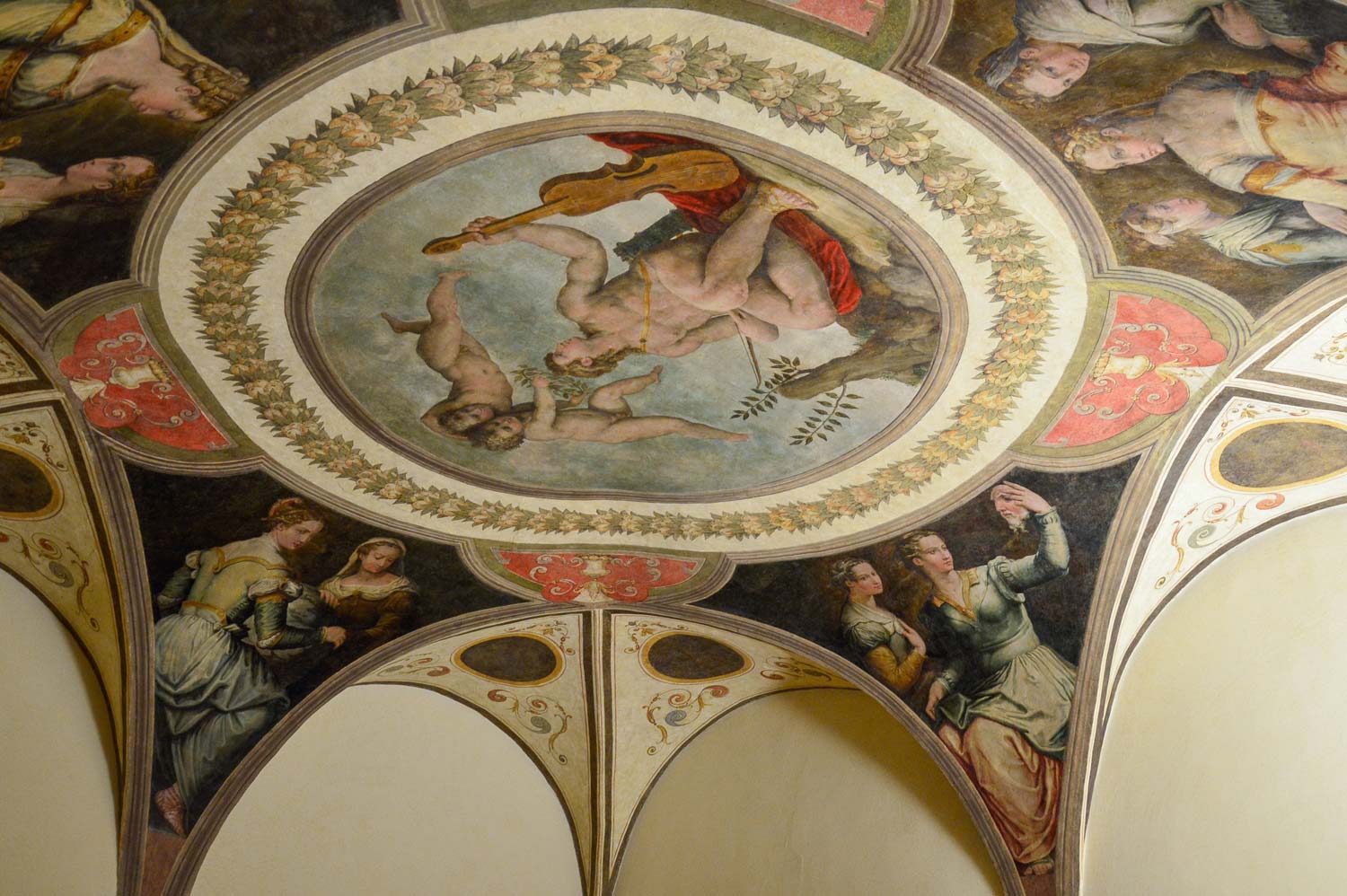 Chamber of Apollo and the
Chamber of Apollo and the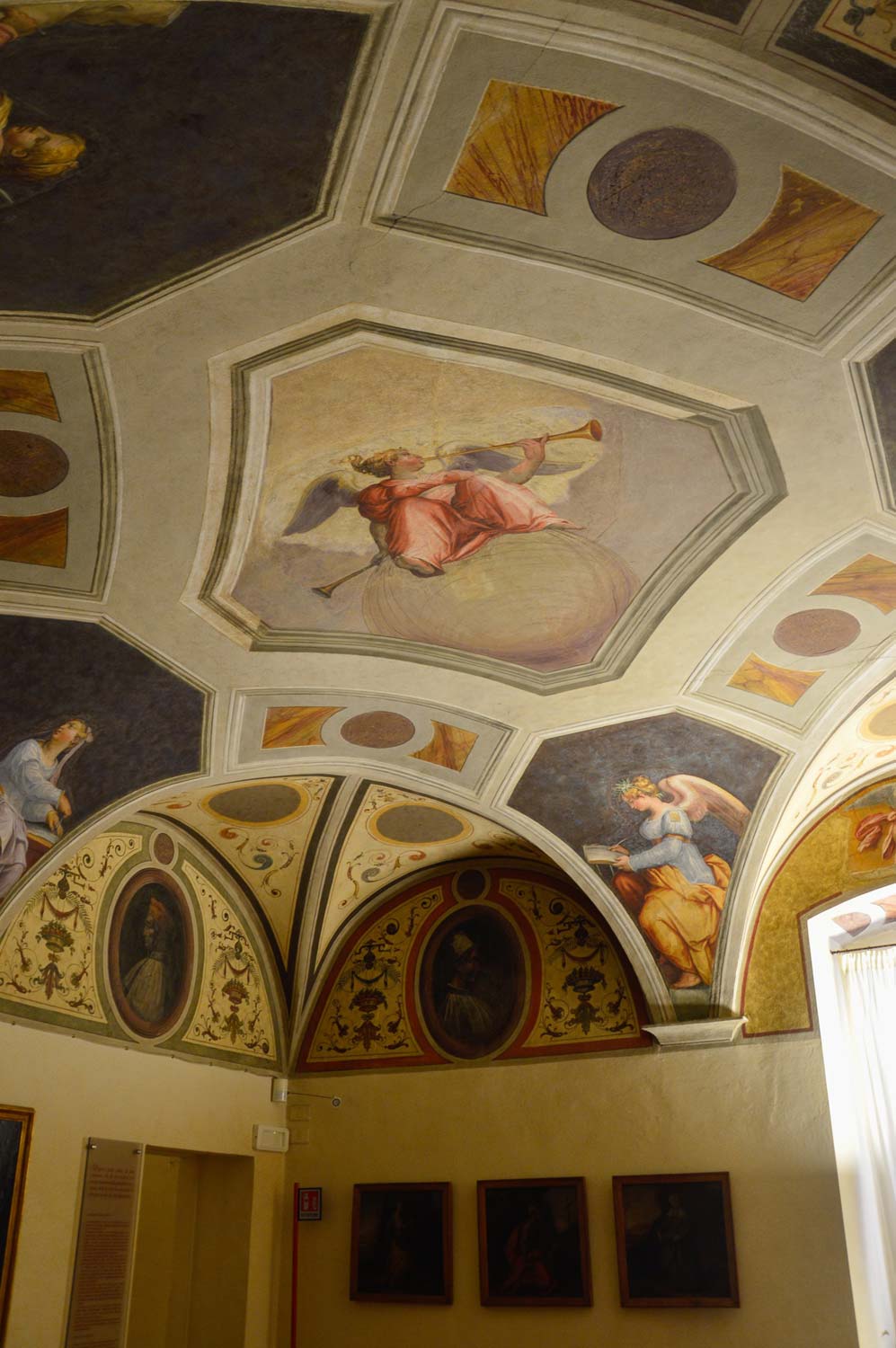 Chamber of
Chamber of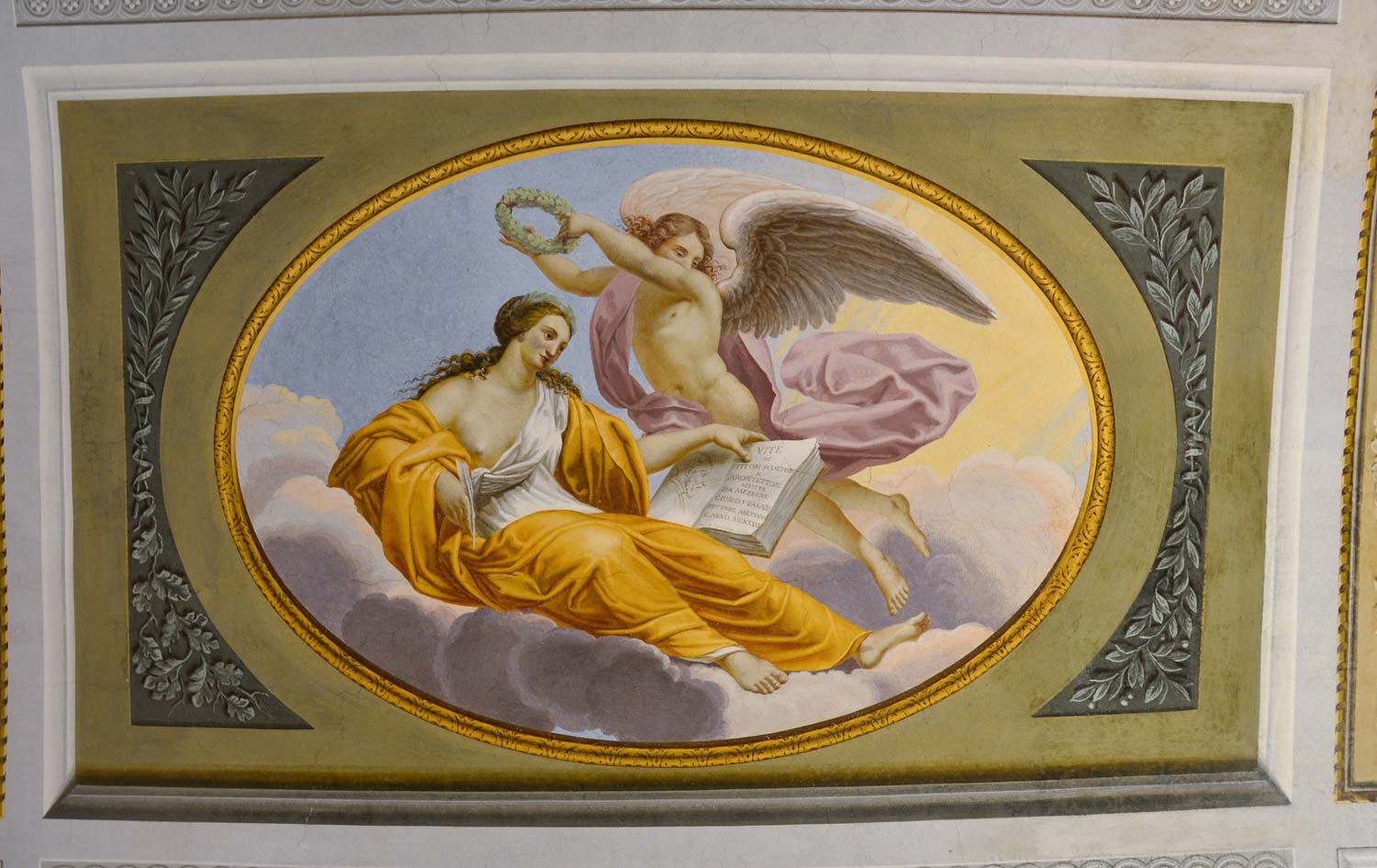
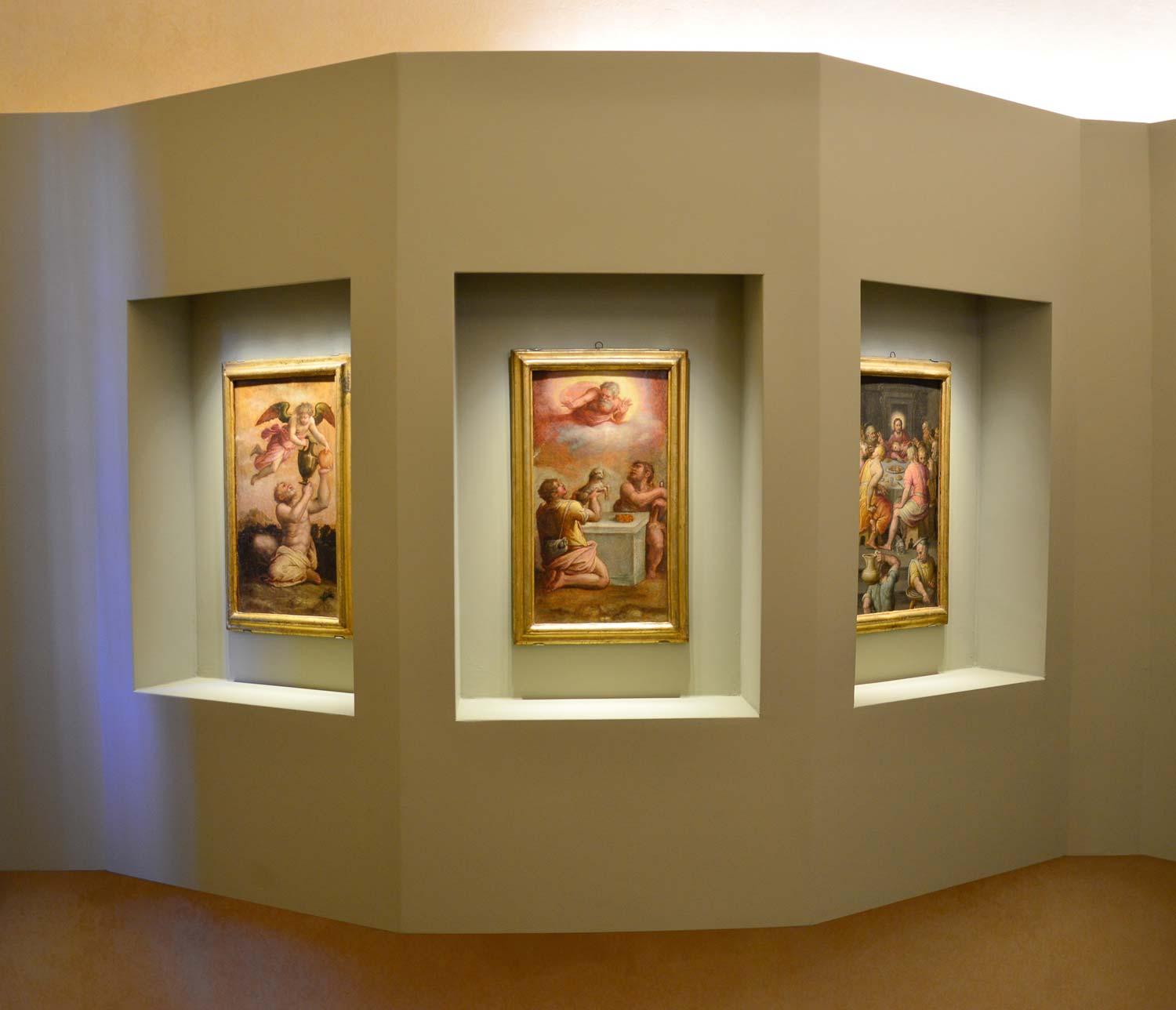
The side walls have a decoration spread over two bands: in the upper one are views of ruins, busts of ancient figures and allegorical figures; in the lower one are represented instead, in monochrome to imitate bronze, anecdotes concerning the lives of ancient painter-artists, taken from the Naturalis Historia of Pliny the Elder. Famous episodes are found there, such as the one featuring Apelles and Campaspe, or the story of Zeusis and the grape. With a reading from the bottom up, it is possible to interpret the totality of the decoration as a celebration of the illustrious artists of the past, whose fame has endured despite the destruction of the ancient world, and who thanks to the virtues overcame nature with their art, represented by the Ephesian Artemis depicted on one of the short walls, which is contrasted by the statue of Venus made by Bartolomeo Ammannati, placed on the large fireplace, representing Art. On the ceiling, Virtue is seen triumphing, but the presence of Fortune emphasizes the changing nature of this victory. The Fireplace Hall is connected to the elevated garden by a small passageway, called the Corridor of Ceres. Indeed, on the ceiling it is possible to admire a tempera-painted panel where the patron goddess of agriculture is depicted. To the right of the corridor, on the other hand, is the Kitchen, which has a more recent decoration than the rest of the house, created in 1831 by the painter Raimondo Zaballi.
The building, purchased by the state in 1911 to make it into a museum, was restored and furnished in the 1950s under the direction of Ubaldo Lumini, director of the detached office of the Soprintendenza ai Monumenti per provincia di Arezzo and conservator of Casa Vasari, and Luciano Berti, who published a short guide to the house-museum in 1955. The room was empty, lacking the original furnishings, and the setting was entrusted to Berti, who selected about fifty works from the deposits of the Florentine galleries, later supplemented with some owned by the Museum of Arezzo, mainly by artists from Vasari’s circle or at any rate coeval with and related to the artist. The choice fell on works that could make visitors aware of the 16th-century Florentine and Tuscan artistic environment in which Vasari moved.
The paintings are arranged by theme; those with mythological subjects are located in the Chamber of Apollo, portraits in the Kitchen, works with sacred subjects in the Room of Fame, while predellas and panels are located in the Corridor of Ceres. Vasari’s works preserved within the house are not many, but prominent among them is Christ Taken to the Tomb, painted when he was just over 20 years old, symbolizing the beginning of his long service with the Medici family. Within the small collection are works by such notable artists as Alessandro Allori, Jacopo Zucchi, whoseApollo and Marsyas and Death of Adonis we can see, Perin del Vaga, and Giovanni Stradano.
In 2011, thanks to a grant from the Ministry of Culture and Tourism, which arrived on the occasion of the five-hundredth anniversary of the artist’s birth, a redevelopment of the museum was carried out, and Michele Loffredo, then the museum’s director, took charge of the refurbishment of the picture gallery. The museum is located on XX Settembre Street; for hours and ticket cost, you can visit the website directly.
 |
| Vasari House in Arezzo: the history and new life of the museum |
Warning: the translation into English of the original Italian article was created using automatic tools. We undertake to review all articles, but we do not guarantee the total absence of inaccuracies in the translation due to the program. You can find the original by clicking on the ITA button. If you find any mistake,please contact us.




























